Easy Way to Tell Between Linear and Exponential Story Problems
You will often see both linear and exponential growth functions in science and math courses. However, it is helpful to see the differences between them compared side-by-side.
So, what is the difference between linear and exponential growth? A linear growth function is graphed as a line, has a constant slope, and increases by a constant amount in each time interval. An exponential growth function is graphed as an increasing convex curve, has an ever-increasing positive slope, and increases by a constant percentage in each time interval.
Of course, the growth function you use will depend on what you are trying to model. For example, linear functions are useful for distance at a constant speed, while exponential functions are useful for population growth and compound interest.
In this article, we'll talk about the differences between linear and exponential growth functions. We'll also answer some common questions and look at some examples to make the concepts clear.
Let's get started.
What Is The Difference Between Linear & Exponential Growth? (Linear vs Exponential Functions)
The key difference between linear and exponential growth is the slope of the curves (that is, the rate of change over time). A linear growth function has a positive constant slope, while an exponential growth function has a positive slope that is always increasing.
Another way of saying this is that the second differences (second derivative) of a linear growth function is zero, while the second differences of an exponential growth function are positive and increasing.
On a graph, a linear growth function is a straight line, while an exponential growth function is an increasing convex (concave up) curve.
A linear function increases by a constant amount (the value of its slope) in each time interval, while an exponential function increases by a constant percentage (or ratio) in each time interval.
For example:
- The linear function f(x) = 2x increases by 2 (a constant slope) every time x increases by 1.
- The exponential function g(x) = 1.02x increases by 2 percent (a constant percentage) every time x increases by 1. [Note: 1.02x = eln(1.02)x]
The following table shows the differences between linear and exponential growth functions at a glance.
| Function Type | Linear | Exponential |
|---|---|---|
| Slope (1st difference) | constant | also an exponential function |
| Concavity 2nd difference) | zero | also an exponential function |
| Equation | ax + b a = slope b = y intercept | cdx c = growth factor d = base |
| Table | look for y values that increase by a constant value | look for y values that increase by a constant ratio |
| Graph | line | increasing convex curve |
| Phrases in a word problem | constant slope, constant speed, constant rate of change | doubling, halving, percent increase, percent decrease, population growth, bacterial growth, radioactive decay. |
and exponential growth functions at a glance.
How Do You Know If An Equation Is Linear Or Exponential?
To tell if an equation is linear or exponential, remember the form of each one:
- A linear equation has the form f(x) = ax + b. [a is the slope, and b is the y-intercept]
- An exponential equation has the form g(x) = cdx. [c is a constant scaling factor, and d is the base – note that we can rewrite as g(x) = celn(d)x, where e is the constant that is approximately 2.718 and ln is the logarithm with base e]
If there is no exponential term (that is, no exponent that contains a variable), then the equation is not exponential.
If there is any power of x other than 1 (linear term) or 0 (constant term), then the equation is not linear.
Example 1: A Linear Equation
Consider the equation f(x) = 2x + 5.
This equation is linear since it has the form ax + b (a = 2 is the slope, and b = 5 is the y-intercept).
Note that there is no exponential term (there is no term with a variable in the exponent].
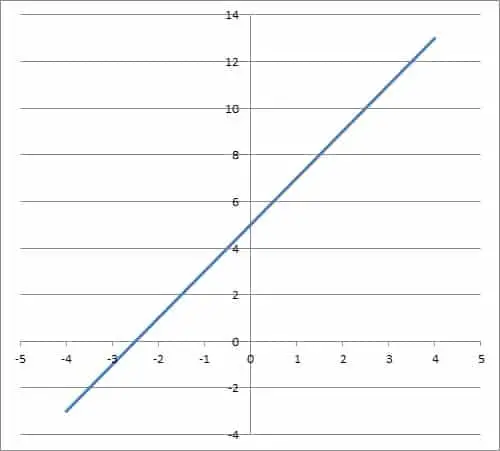
Example 2: An Exponential Equation
Consider the equation f(x) = 2*3x
This equation is exponential since it has the form cdx (c = 2 is the constant scaling factor, and d = 3 is the base).
Note that there is no linear term (there is no term with a variable in the exponent].
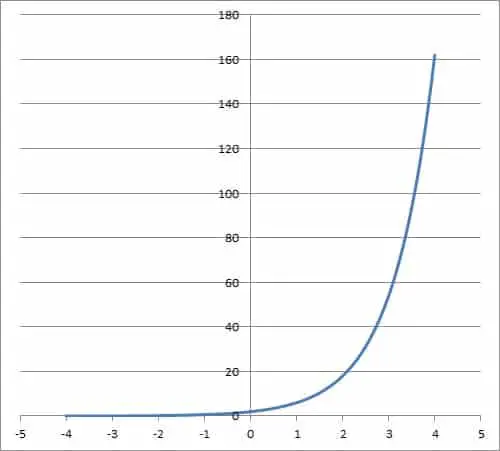
Example 3: An Equation That Is Neither Linear Nor Exponential
Consider the equation f(x) = x2 + 5.
This equation is not linear, since it has a quadratic term (x2). Thus, it does not have the form ax + b, which is required for a linear equation.
This equation is not exponential, since there is no term with a variable in the exponent. Thus, it does not have the form cdx, which is required for an exponential function.
In fact, this is a quadratic function. It has the graph of a parabola.
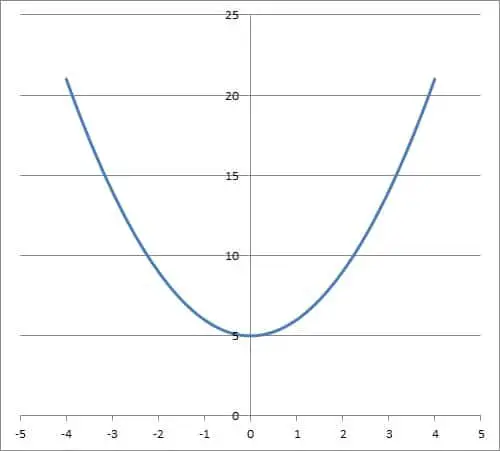
How Do You Know If A Table Is Linear Or Exponential?
To tell if a table of x and y values represents a linear or exponential graph, add some columns to the table:
- First differences of x
- First differences of y
- Slope – that is, the ratio of: (first differences of y) / (first differences of x)
Now, examine the entries in the slope column to determine they type of function that the data represents:
- If the entries in the slope column are constant, then the data in the table represents a linear function.
- If the entries in the slope column increase by the same percentage (ratio) each time, then the data in the table represents an exponential function.
- If neither of these are true, then the data in the table represents some other type of function. For example, if the slope increases by the same amount each time (constant second differences), then we have a quadratic function.
Example 1: Table Of Values For A Linear Function
Consider the following table of values:
| x | y |
|---|---|
| 0 | 2 |
| 1 | 5 |
| 2 | 8 |
| 3 | 11 |
| 4 | 14 |
| 5 | 17 |
| 6 | 20 |
| 7 | 23 |
We can add 3 columns to the table: first differences of x, first differences of y, and slope – that is, the ratio of (first differences of y) / (first differences of x):
| x | y | First Differences of x | First Differences of y | Slope |
|---|---|---|---|---|
| 0 | 2 | |||
| 1 | 5 | 1 | 3 | 3/1 = 3 |
| 2 | 8 | 1 | 3 | 3/1 = 3 |
| 3 | 11 | 1 | 3 | 3/1 = 3 |
| 4 | 14 | 1 | 3 | 3/1 = 3 |
| 5 | 17 | 1 | 3 | 3/1 = 3 |
| 6 | 20 | 1 | 3 | 3/1 = 3 |
| 7 | 23 | 1 | 3 | 3/1 = 3 |
Since all of the slopes are the same, we know that we have a constant function. In fact, its equation is y = 3x + 2.
Example 2: Table Of Values For An Exponential Function
Consider the following table of values:
| x | x |
|---|---|
| 0 | 5 |
| 1 | 10 |
| 2 | 20 |
| 3 | 40 |
| 4 | 80 |
| 5 | 160 |
| 6 | 320 |
We can add 3 columns to the table: first differences of x, first differences of y, and slope – that is, the ratio of (first differences of y) / (first differences of x):
| x | y | First Differences of x | First Differences of y | Slope |
|---|---|---|---|---|
| 0 | 5 | |||
| 1 | 10 | 1 | 5 | 5 |
| 2 | 20 | 1 | 10 | 10 |
| 3 | 40 | 1 | 20 | 20 |
| 4 | 80 | 1 | 40 | 40 |
| 5 | 160 | 1 | 80 | 80 |
| 6 | 320 | 1 | 160 | 160 |
Since the slope increases by the same ratio (times 2) each time, we know that we have an exponential function. In fact, its equation is y = 5*2x.
Example 3: Table Of Values For A Quadratic Function
Consider the following table of values:
| x | y |
|---|---|
| 0 | 1 |
| 2 | 5 |
| 4 | 17 |
| 6 | 37 |
| 8 | 65 |
| 10 | 101 |
| 12 | 145 |
| 14 | 197 |
We can add 3 columns to the table: first differences of x, first differences of y, and slope – that is, the ratio of (first differences of y) / (first differences of x):
| x | y | First Differences of x | First Differences of y | Slope |
|---|---|---|---|---|
| 0 | 1 | |||
| 2 | 5 | 2 | 4 | 2 |
| 4 | 17 | 2 | 12 | 6 |
| 6 | 37 | 2 | 20 | 10 |
| 8 | 65 | 2 | 28 | 14 |
| 10 | 101 | 2 | 36 | 18 |
| 12 | 145 | 2 | 44 | 22 |
| 14 | 197 | 2 | 52 | 26 |
Since the slope increases by the same amount (plus 4) each time, we know that we have a quadratic function. In fact, its equation is y = x2 + 1.
How Do You Know If A Graph Is Linear Or Exponential?
A graph is linear if it has a constant slope (it always increases at the same rate). The graph is a straight line, and it can also be horizontal (y = b, zero slope) or vertical (x = a, undefined slope).
The graph below is a linear function.
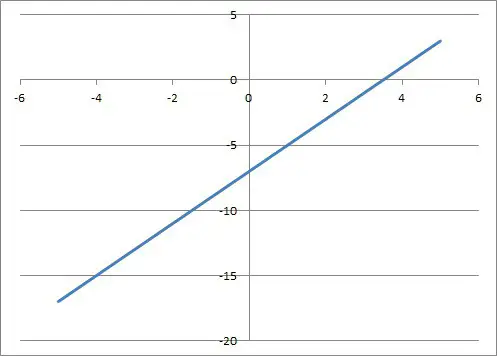
A graph is one of exponential growth if it has a positive and ever-increasing slope (it is convex or concave up, since the second derivative is always positive. The slope gets larger as x gets larger.
The graph below is one of exponential growth.
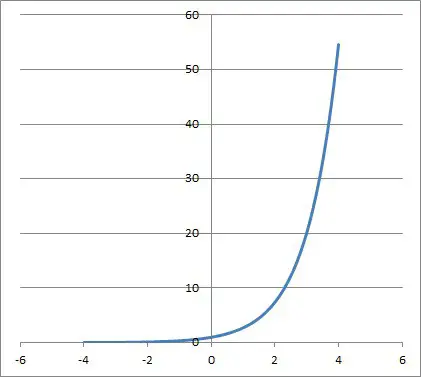
A graph is one of exponential decay if it has a negative and ever-decreasing slope (it is concave or concave up, since the second derivative is always positive. The slope approaches zero as x gets larger.
The graph below is one of exponential decay.
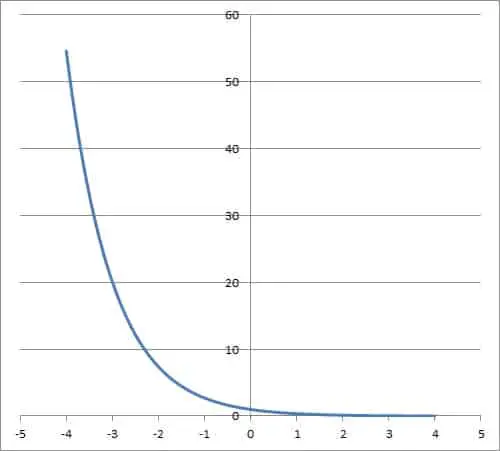
How Do You Know If A Word Problem Is Linear Or Exponential?
You can tell if a word problem is linear or exponential by paying close attention to the key phrases.
If a word problem mentions that a quantity increases by the same amount (or a constant amount) in every time interval, then use a linear function to model the problem.
Some other phrases that suggest linear functions are constant slope, constant rate of change, and constant speed.
If a word problem mentions that a quantity increases by the same percentage (or the same ratio) in every time interval, then use an exponential function to model the problem.
Some other phrases that suggest exponential growth (or decay) are doubling, tripling, halving, percent increase, percent decrease, population growth, bacterial growth, and radioactive decay.
Example 1: Linear Growth Word Problem
Let's say that we start at 10 miles north of Boston, and we are driving north at a constant speed of 60 miles per hour. Write a function to tell us how far north of Boston we are after H hours.
Since our speed is constant (60 miles per hour), this implies a constant slope, so we will use a linear function to model the situation.
For a linear function, we have the equation
- D = aH + b
where a is the slope (speed) and b is the y intercept (starting distance north of Boston.) D is the distance north of Boston after H hours, and H is the time that has passed in hours.
We know that the speed of 60 miles per hour represents our sloe, so a = 60. This gives us:
- D = 60H + b
Now we just need to find the value of b. Remember that we started at a distance of D = 10 miles north of Boston (at time H = 0), which gives us:
- 10 = 60(0) + b [D = 10, H = 0]
- 10 = b
So, we can write the full linear equation:
- D = 60H + 10
So after 5 hours, we will be a distance of D = 60(5) + 10 = 310 miles north of Boston.
Example 2: Exponential Growth Word Problem
Let's say that we have $100 in a savings account at the bank, and it grows at a constant rate of 2% per year. Write a function to tell us how much money we have in the savings account after Y years.
This is a compound interest problem. Since our growth rate is a constant percentage increase (2% per year), we will use an exponential function to model this scenario.
Our exponential function has the form
- A = cdY
Where A is the savings account balance at time Y, Y is the time in years, c is a constant scaling factor, and d is the growth rate.
Since our growth is a constant 2% per year (0.02 as a decimal), we use d = 1 + 0.02 = 1.02 as our growth rate. This gives us:
- A = c(1.02)Y
Now we just need to find the value of c. Remember that we started with $100 in the bank account at time Y = 0 years, which gives us:
- 100 = c(1.02)0
- 100 = c(1) [a number raised to the power of zero equals 1]
- 100 = c
So, we can write the full exponential equation:
- A = 100(1.02)Y
So after 10 years, we will have a savings account balance of A = 100(1.02)10 = $121.90.
Conclusion
Now you know the difference between linear and exponential growth functions. You also know the answers to some common questions about how to tell them apart.
If you want to know more about lines and slopes, you can learn about when lines are parallel in my article here.
You can learn how to calculate annual and monthly compound growth rates (exponential growth) in my article here.
You can learn how to find the formula of an exponential function here.
You can learn about the difference between quadratic and exponential functions here.
You can also learn about the differences between linear and quadratic functions here.
You can learn more about the natural base e ~ 2.718 here.
I hope you found this article helpful. If so, please share it with someone who can use the information.
Don't forget to subscribe to my YouTube channel & get updates on new math videos!
~Jonathon
Source: https://jdmeducational.com/linear-vs-exponential-growth-functions-3-key-ideas/
0 Response to "Easy Way to Tell Between Linear and Exponential Story Problems"
Post a Comment